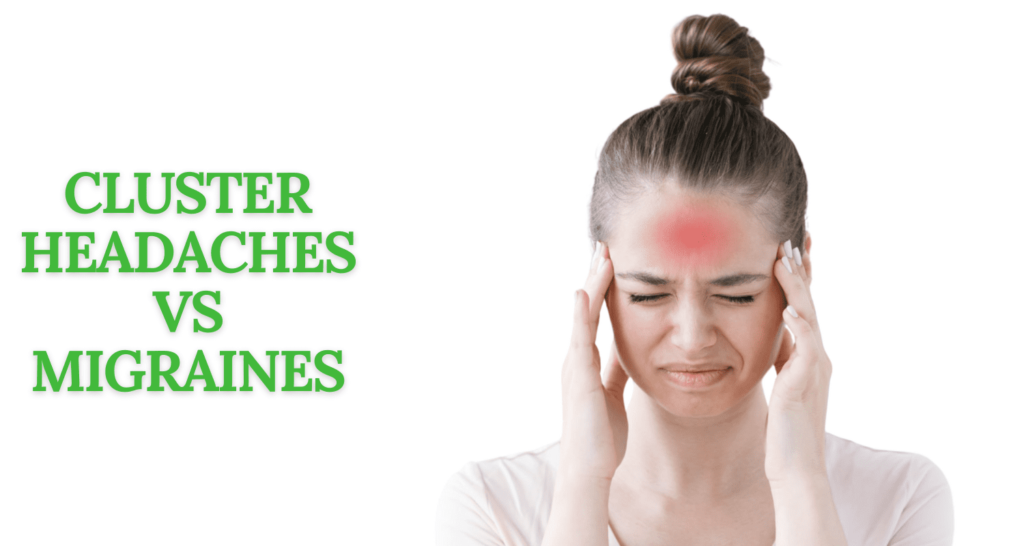Did you know that more than 45 million people in the United States alone suffer from migraines?
But that’s not the whole picture when it comes to debilitating headaches.
Cluster headaches, although less common, are just as severe and can significantly impact a person’s quality of life.
In this article, we will explore the key differences between cluster headaches vs migraines, shedding light on their symptoms, causes, and treatment options.
By understanding the distinctions between these two headache types, you can better navigate your own experience or support those around you facing these challenges.
Let’s explore cluster headaches vs migraines.
Key Takeaways:
- In headache comparison, cluster headaches vs migraines, both are severe headache disorders that affect millions of people.
- Cluster headaches are less common but known for their excruciating pain and associated symptoms like eye redness and tearing.
- Migraines are more prevalent and can cause severe head pain, nausea, and sensitivity to light and sound.
- Effective management of cluster headaches and migraines often involves a combination of medical treatments and lifestyle modifications.
- Seeking professional help and personalized treatment plans are crucial for those living with cluster headaches or migraines.
Understanding Cluster Headaches
Cluster headaches are a distinct type of headache that differ from other headache types in terms of their specific symptoms, causes, and characteristics.
By understanding the unique aspects of cluster headaches, individuals can gain valuable insights into this debilitating condition.
Symptoms:
- Intense, excruciating pain that is localized to one side of the head
- Severe burning or piercing sensation behind or around the eye
- Red or teary eye on the affected side
- Stuffy or runny nose on the affected side
- Sweating and facial flushing
Cluster Headache Causes:
The exact cause of cluster headaches is still unknown. However, researchers believe that several factors contribute to their development:
- Abnormalities in the hypothalamus, a region of the brain that regulates sleep, body temperature, and autonomic functions
- Genetic predisposition, as cluster headaches tend to run in families
- Imbalances in brain chemicals, such as serotonin
- Triggers, including alcohol consumption, smoking, high altitudes, and certain medications
Differentiating Cluster Headaches from Other Types of Headaches:
Cluster headaches have distinct features that set them apart from other headache types.
The key differentiators include:
- The intensity and duration of the pain: Cluster headaches are characterized by short but extremely painful attacks that typically last between 15 minutes and 3 hours. Unlike migraines, which can last for hours or even days, cluster headaches are known for their shorter duration.
- Pattern of attacks: Cluster headaches occur in clusters or episodes, with individuals experiencing multiple attacks per day for several weeks or months. These episodes are followed by periods of remission, during which the headaches are absent for an extended period.
- Location of pain: Cluster headaches commonly manifest as severe pain behind the eye, whereas migraines often involve pain on both sides of the head.
Understanding the specific symptoms, causes, and distinguishing factors of cluster headaches is crucial for accurate diagnosis and effective management.
By recognizing the unique characteristics of cluster headaches, individuals can seek appropriate medical attention and explore targeted treatment options tailored to their specific needs.
Unveiling Migraines: Symptoms and Causes
This section will delve into the world of migraines, providing a comprehensive understanding of their symptoms and underlying causes.
Migraines are a distinct type of headache that differ from cluster headaches and other forms of headaches.
Migraine Symptoms:
- Throbbing or pulsating pain, often on one side of the head
- Sensitivity to light, sound, or even smells
- Nausea and vomiting
- Visual disturbances, such as seeing flashing lights or blind spots
- Intense, debilitating pain that can last for hours or even days
These unique symptoms set migraines apart from other headache types, making them easily distinguishable.
Migraine Triggers:
- Stress and anxiety
- Hormonal changes in women
- Environmental factors, such as bright lights or strong odors
- Specific foods and drinks, like chocolate, caffeine, and alcohol
- Changes in sleep patterns or sleep disturbances
Understanding the triggers can help individuals manage and prevent migraines from occurring.
By examining the symptoms and triggers associated with migraines, this section will provide readers with valuable insights into this debilitating headache condition, allowing them to better differentiate migraines from other types of headaches.
Comparing Cluster Headaches vs Migraines: Symptoms and Triggers
Cluster headaches and migraines may both cause intense pain, but understanding their differences in symptoms and triggers is crucial for proper diagnosis and treatment.
Let’s explore how these two headache types differ in terms of symptomatology:
Symptoms:
Cluster headaches:
- Severe, piercing pain localized around one eye or temple
- Unilateral pain that can radiate to the forehead, neck, and shoulder
- Restlessness and agitation during an attack
- Tearing, redness, and sweating on the affected side of the face
- Stuffy or runny nose
Migraines:
- Throbbing or pulsating headache that can occur on one or both sides of the head
- Sensitivity to light, sound, and odors
- Nausea and vomiting
- Aura, which can consist of visual disturbances or numbness
- Intense fatigue before and after an attack
Triggers:
Cluster headaches:
- Alcohol consumption
- Tobacco use and exposure
- Changes in sleep patterns
- High altitudes
- Strong odors
Migraines:
- Hormonal changes
- Stress and anxiety
- Specific foods or food additives
- Food triggers such as caffeine or artificial sweeteners
- Environmental factors like bright lights or strong smells
By understanding these differences in symptoms and triggers, individuals affected by cluster headaches or migraines can work with healthcare professionals to develop personalized treatment plans that address their specific needs and provide effective relief.
Treatment Strategies and Management
When it comes to managing and treating cluster headaches vs migraines, it’s crucial to explore a range of headache treatments to find what works best for you.
While there is no one-size-fits-all approach, understanding the available treatment strategies and implementing effective headache management techniques can greatly improve your quality of life.
Medical Treatment Options
- Medication: Your healthcare provider may prescribe medications specifically designed to target the symptoms and underlying causes of cluster headaches and migraines. These may include pain relievers, triptans, or preventive medications.
- Injection Therapies: In certain cases, injection therapies such as occipital nerve blocks or botulinum toxin injections may be recommended to provide immediate relief or prevent headache episodes.
- Oxygen Therapy: Inhalation of 100% oxygen through a mask has shown to alleviate cluster headache pain within minutes for many patients.
Lifestyle Changes and Non-Medical Approaches
- Identifying Triggers: Keeping a headache diary can help you identify and avoid triggers that often precede cluster headaches or migraines. Common triggers include stress, certain foods, bright lights, and strong odors.
- Stress Management Techniques: Practicing relaxation techniques such as deep breathing exercises, meditation, or yoga can help reduce stress levels and potentially decrease the frequency and intensity of headaches.
- Regular Sleep Patterns: Establishing a consistent sleep routine and getting enough restful sleep each night can be beneficial in managing cluster headaches and migraines.
- Healthy Lifestyle Habits: Maintaining a balanced diet, regular exercise routine, and staying hydrated are important factors in reducing the frequency and severity of headache episodes.
Remember, effective headache management often requires a combination of techniques, both medical and non-medical.
It’s crucial to work closely with your healthcare provider to develop a personalized treatment plan that addresses your specific needs and aims to provide long-term relief and improved headache management.
Conclusion
To effectively manage and find relief from cluster headaches and migraines, it is crucial to understand the differentiating headaches between cluster headaches vs migraines headache conditions.
While cluster headaches are characterized by intense, excruciating pain and occur in clusters or cycles, migraines are often accompanied by throbbing pain, nausea, and sensitivity to light and sound.
Identifying the specific symptoms that align with each headache type is essential for accurate diagnosis and appropriate treatment.
In cluster headaches vs migraines, proper diagnosis plays a vital role in determining the most effective headache relief strategies.
If you suspect you are experiencing either cluster headaches or migraines, consult a healthcare professional who specializes in headaches. They can conduct a thorough evaluation and recommend personalized treatment plans tailored to your specific needs.
When it comes to headache relief strategies, a holistic approach is often the most effective.
Alongside medical interventions such as prescription medications, lifestyle modifications can greatly reduce headache frequency and severity.
These may include stress management techniques, regular exercise, maintaining a consistent sleep schedule, and avoiding known triggers.
Remember, finding relief from cluster headaches and migraines may require some trial and error.
Each individual is unique, and what works for one person may not work for another.
It is essential to work closely with your healthcare provider, keep a headache diary to identify patterns and triggers, and adapt your treatment plan accordingly.
With the right combination of personalized headache relief strategies, you can regain control and reduce the impact of these debilitating conditions on your daily life.
FAQs
What are the differences between cluster headaches vs migraines?
Cluster headaches typically occur in clusters over weeks or months, with intense pain around one eye, while migraines often involve throbbing pain on one side of the head and can last longer.
How can you tell the difference between cluster headaches vs migraines?
Cluster headaches are often shorter in duration but more intense, accompanied by symptoms like eye tearing and nasal congestion, whereas migraines may last longer with symptoms like nausea and sensitivity to light and sound.
Do cluster headaches hurt worse than migraines?
Cluster headaches are often described as extremely painful, sometimes even referred to as “suicide headaches,” due to their severity. Migraines can also be debilitating, but the intensity may vary from person to person.
How can you tell the difference between a migraine and a headache?
Headaches are generally less severe and can be caused by various factors like stress or tension, whereas migraines and cluster headaches have specific characteristics such as duration, location, and associated symptoms.
What triggers cluster headaches?
Triggers for cluster headaches can include alcohol consumption, certain foods, changes in sleep patterns, and environmental factors like strong smells or bright lights.
How bad are cluster migraines?
Cluster headaches are often considered one of the most painful conditions, with intense, excruciating pain usually centered around one eye, sometimes accompanied by restlessness or agitation.
How I cured my cluster headaches?
Treatment for cluster headaches typically involves medications like triptans, oxygen therapy, or preventive medications. It’s essential to consult a healthcare professional for personalized treatment options and management strategies.
Disclaimer: This content, including advice, provides generic information only. It is not a substitute for a qualified medical opinion. Always consult a specialist or your doctor for more information. Nutrition Cult does not claim responsibility for this information.




